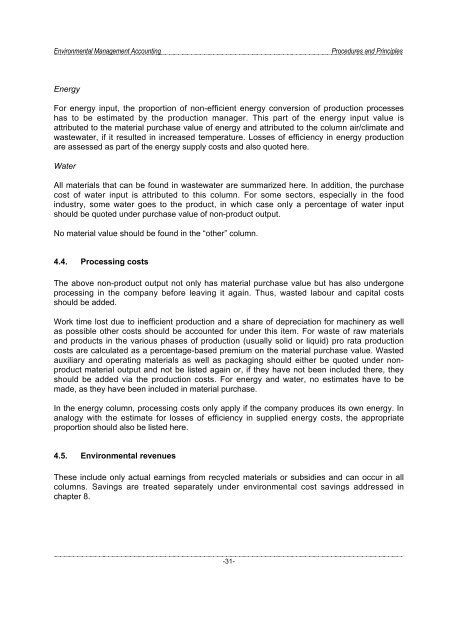Environmental Management Accounting Procedures and Principles
Environmental Management Accounting Procedures and Principles
Environmental Management Accounting Procedures and Principles
Create successful ePaper yourself
Turn your PDF publications into a flip-book with our unique Google optimized e-Paper software.
<strong>Environmental</strong> <strong>Management</strong> <strong>Accounting</strong><br />
<strong>Procedures</strong> <strong>and</strong> <strong>Principles</strong><br />
Energy<br />
For energy input, the proportion of non-efficient energy conversion of production processes<br />
has to be estimated by the production manager. This part of the energy input value is<br />
attributed to the material purchase value of energy <strong>and</strong> attributed to the column air/climate <strong>and</strong><br />
wastewater, if it resulted in increased temperature. Losses of efficiency in energy production<br />
are assessed as part of the energy supply costs <strong>and</strong> also quoted here.<br />
Water<br />
All materials that can be found in wastewater are summarized here. In addition, the purchase<br />
cost of water input is attributed to this column. For some sectors, especially in the food<br />
industry, some water goes to the product, in which case only a percentage of water input<br />
should be quoted under purchase value of non-product output.<br />
No material value should be found in the “other” column.<br />
4.4. Processing costs<br />
The above non-product output not only has material purchase value but has also undergone<br />
processing in the company before leaving it again. Thus, wasted labour <strong>and</strong> capital costs<br />
should be added.<br />
Work time lost due to inefficient production <strong>and</strong> a share of depreciation for machinery as well<br />
as possible other costs should be accounted for under this item. For waste of raw materials<br />
<strong>and</strong> products in the various phases of production (usually solid or liquid) pro rata production<br />
costs are calculated as a percentage-based premium on the material purchase value. Wasted<br />
auxiliary <strong>and</strong> operating materials as well as packaging should either be quoted under nonproduct<br />
material output <strong>and</strong> not be listed again or, if they have not been included there, they<br />
should be added via the production costs. For energy <strong>and</strong> water, no estimates have to be<br />
made, as they have been included in material purchase.<br />
In the energy column, processing costs only apply if the company produces its own energy. In<br />
analogy with the estimate for losses of efficiency in supplied energy costs, the appropriate<br />
proportion should also be listed here.<br />
4.5. <strong>Environmental</strong> revenues<br />
These include only actual earnings from recycled materials or subsidies <strong>and</strong> can occur in all<br />
columns. Savings are treated separately under environmental cost savings addressed in<br />
chapter 8.<br />
-31-




